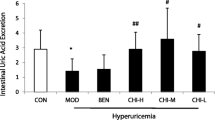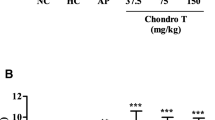Abstract
Background
Renal organic ion transporters and uromodulin (UMOD) play the important roles in renal urate excretion and function. Hyperuricemia is considered as a risk factor for the development of renal dysfunction. The flavonoid quercetin in diets exerts the hypouricemic and nephroprotective effects.
Purposes
To evaluate the effects of quercetin on renal organic ion transporters and UMOD in hyperuricemic mice.
Methods
Kun-Ming mice were divided into normal and hyperuricemic groups receiving water, 25, 50 and 100 mg/kg quercetin, 5 mg/kg allopurinol, respectively. Hyperuricemic mice were orally gavaged with 250 mg/kg oxonate daily for 1 week. Quercetin and allopurinol were orally gavaged on the day when oxonate or water was given 1 h later. After 1 week, serum uric acid, creatinine and blood urea nitrogen concentrations, excretion of urate and creatinine, and fractional excretion of uric acid were measured. The mRNA and protein levels of renal urate transporter 1 (mURAT1), glucose transporter 9 (mGLUT9), organic anion transporter 1 (mOAT1) and organic cation/carnitine transporters (mOCT1, mOCT2, mOCTN1 and mOCTN2) in mice were analyzed. Simultaneously, UMOD levels in serum, urine and kidney, as well as renal UMOD mRNA expression were detected.
Results
Quercetin significantly restored oxonate-induced abnormalities of these biochemical indexes compared with normal vehicle group. Furthermore, it remarkably prevented expression changes of renal organic ion transporters and UMOD, and UMOD level alteration in hyperuricemic mice.
Conclusions
These results suggest that quercetin has the uricosuric and nephroprotective actions mediated by regulating the expression levels of renal organic ion transporters and UMOD.




Similar content being viewed by others
Abbreviations
- OAT:
-
Organic anion transporter
- URAT1:
-
Urate transporter 1
- GLUT9:
-
Glucose transporter 9
- OCT:
-
Organic cation transporter
- OCTN:
-
Organic cation/carnitine transporter
- FEUA:
-
Fractional excretion of uric acid
- Sur:
-
Serum uric acid concentration
- Scr:
-
Serum creatinine concentration
- Uur:
-
Urine uric acid concentration
- Ucr:
-
urine creatinine concentration
- UMOD:
-
Uromodulin
- RT-PCR:
-
Reverse transcriptase-polymerase chain reaction
- BBMV:
-
Brush border membrane vesicles
- BUN:
-
Blood urea nitrogen
References
Feig DI, Kang DH, Johnson RJ (2008) Uric acid and cardiovascular risk. N Engl J Med 359:1811–1821
Richette P, Bardin T (2010) Gout. Lancet 375:318–328
Hosoyamada M, Ichida K, Enomoto A et al (2004) Function and localization of urate transporter 1 in mouse kidney. J Am Soc Nephrol 15:261–268
Nigam SK, Bush KT, Bhatnagar V (2007) Drug and toxicant handling by the OAT organic anion transporters in the kidney and other tissues. Nat Clin Pract Nephrol 3:443–448
Vitart V, Rudan I, Hayward C et al (2008) SLC2A9 is a newly identified urate transporter influencing serum urate concentration, urate excretion and gout. Nat Genet 40:437–442
Preitner F, Bonny O, Laverrière A et al (2009) Glut9 is a major regulator of urate homeostasis and its genetic inactivation induces hyperuricosuria and urate nephropathy. Proc Natl Acad Sci USA 106:15501–15506
Enomoto A, Kimura H, Chairoungdua A et al (2002) Molecular identification of a renal urate anion exchanger that regulates blood urate levels. Nature 417:447–452
Grover B, Buckley D, Buckley AR et al (2004) Reduced expression of organic cation transporters rOCT1 and rOCT2 in experimental diabetes. J Pharmacol Exp Ther 308:949–956
Tokuhiro S, Yamada R, Chang X et al (2003) An intronic SNP in a RUNX1 binding site of SLC22A4, encoding an organic cation transporter, is associated with rheumatoid arthritis. Nat Genet 35:341–348
Glube N, Closs E, Langguth P (2007) OCTN2-mediated carnitine uptake in a newly discovered human proximal tubule cell line (Caki-1). Mol Pharm 4:160–168
Rizwan AN, Burckhardt G (2007) Organic anion transporters of the SLC22 family: biopharmaceutical, physiological, and pathological roles. Pharm Res 24:450–470
Dahan K, Devuyst O, Smaers M et al (2003) A cluster of mutations in the UMOD gene causes familial juvenile hyperuricemic nephropathy with abnormal expression of uromodulin. J Am Soc Nephrol 14:2883–2893
Hart TC, Gorry MC, Hart PS et al (2002) Mutations of the UMOD gene are responsible for medullary cystic kidney disease 2 and familial juvenile hyperuricaemic nephropathy. J Med Genet 39:882–892
Kemter E, Rathkolb B, Rozman J et al (2009) Novel missense mutation of uromodulin in mice causes renal dysfunction with alterations in urea handling, energy, and bone metabolism. Am J Physiol Renal Physiol 297:1391–1398
Egert S, Bosy-Westphal A, Seiberl J et al (2009) Quercetin reduces systolic blood pressure and plasma oxidised low-density lipoprotein concentrations in overweight subjects with a high-cardiovascular disease risk phenotype: a double-blinded, placebo-controlled cross-over study. Br J Nutr 102:1065–1074
Perez-Vizcaino F, Duarte J, Jimenez R et al (2009) Antihypertensive effects of the flavonoid quercetin. Pharmacol Rep 61:67–75
Zhu JX, Wang Y, Kong LD et al (2004) Effects of Biota orientalis extract and its flavonoid constituents, quercetin and rutin on serum uric acid levels in oxonate-induced mice and xanthine dehydrogenase and xanthine oxidase activities in mouse liver. J Ethnopharmacol 93:133–140
Mo SF, Zhou F, Lv YZ et al (2007) Hypouricemic action of selected flavonoids in mice: structure-activity relationships. Biol Pharm Bull 30:1551–1556
Hu QH, Wang C, Li JM et al (2009) Allopurinol, rutin, and quercetin attenuate hyperuricemia and renal dysfunction in rats induced by fructose intake: renal organic ion transporter involvement. Am J Physiol Renal Physiol 297:1080–1091
Singh D, Chander V, Chopra K (2004) The effect of quercetin, a bioflavonoid on ischemia/reperfusion induced renal injury in rats. Arch Med Res 35:484–494
Renugadevi J, Prabu SM (2010) Quercetin protects against oxidative stress-related renal dysfunction by cadmium in rats. Exp Toxicol Pathol 62:471–481
Graf BA, Ameho C, Dolnikowski GG et al (2006) Rat gastrointestinal tissues metabolize quercetin. J Nutr 136:39–44
Bieger J, Cermak R, Blank R et al (2008) Tissue distribution of quercetin in pigs after long-term dietary supplementation. J Nutr 138:1417–1420
Hong SS, Seo K, Lim SC et al (2007) Interaction characteristics of flavonoids with human organic anion transporter 1 (hOAT1) and 3 (hOAT3). Pharmacol Res 56:468–473
Ofer M, Wolffram S, Koggel A et al (2005) Modulation of drug transport by selected flavonoids: involvement of P-gp and OCT? Eur J Pharm Sci 25:263–271
Taur JS, Rodriguez-Proteau R (2008) Effects of dietary flavonoids on the transport of cimetidine via P-glycoprotein and cationic transporters in Caco-2 and LLC-PK1 cell models. Xenobiotica 38:1536–1550
Bibert S, Hess SK, Firsov D et al (2009) Mouse GLUT9: evidences for a urate uniporter. Am J Physiol Renal Physiol 297:612–619
Hu QH, Jiao RQ, Wang X et al (2010) Simiao pill ameliorates urate underexcretion and renal dysfunction in hyperuricemic mice. J Ethnopharmacol 128:685–692
Nickel T, Hanssen H, Sisic Z et al (2011) Immunoregulatory effects of the flavonol quercetin in vitro and in vivo. Eur J Nutr 50:163–172
Edwards RL, Lyon T, Litwin SE et al (2007) Quercetin reduces blood pressure in hypertensive subjects. J Nutr 137:2405–2411
Kalogeromitros D, Makris M, Chliva C et al (2008) A quercetin containing supplement reduces niacin-induced flush in humans. Int J Immunopathol Pharmacol 21:509–514
Chen Q (1994) Chinese medicine pharmacology research technology. The people’s medical publishing house, Beijing
Abdel-Raheem IT, Abdel-Ghany AA, Mohamed GA (2009) Protective effect of quercetin against gentamicin-induced nephrotoxicity in rats. Biol Pharm Bull 32:61–67
Perez-Ruiz F, Calabozo M, Erauskin GG et al (2002) Renal underexcretion of uric acid is present in patients with apparent high urinary uric acid output. Arthritis Rheum 47:610–613
Okamoto T (2005) Safety of quercetin for clinical application (review). Int J Mol Med 16:275–278
Harwood M, Danielewska-Nikiel B, Borzelleca JF et al (2007) A critical review of the data related to the safety of quercetin and lack of evidence of in vivo toxicity, including lack of genotoxic/carcinogenic properties. Food Chem Toxicol 45:2179–2205
Katske F, Shoskes DA, Sender M et al (2001) Treatment of interstitial cystitis with a quercetin supplement. Tech Urol 7:44–46
Wong CC, Botting NP, Orfila C et al (2011) Flavonoid conjugates interact with organic anion transporters (OATs) and attenuate cytotoxicity of adefovir mediated by organic anion transporter 1 (OAT1/SLC22A6). Biochem Pharmacol 81:942–949
Bleyer AJ, Hart TC, Willingham MC et al (2005) Clinico-pathologic findings in medullary cystic kidney disease type 2. Pediatr Nephrol 20:824–827
Cappuccio FP, Strazzullo P, Farinaro E et al (1993) Uric acid metabolism and tubular sodium handling. Results from a population-based study. JAMA 270:354–359
Cappuccio FP, Iacone R, Strazzullo P (1991) Serum uric acid and proximal sodium excretion: an independent association in man (the Olivetti Study). J Hypertens Suppl 9:280–281
Eräranta A, Kurra V, Tahvanainen AM et al (2008) Oxonic acid-induced hyperuricemia elevates plasma aldosterone in experimental renal insufficiency. J Hypertens 26:1661–1668
Ruiz MJ, Fernández M, Picó Y et al (2009) Dietary administration of high doses of pterostilbene and quercetin to mice is not toxic. J Agric Food Chem 57:3180–3186
Janssen K, Mensink RP, Cox FJ et al (1998) Effects of the flavonoids quercetin and apigenin on hemostasis in healthy volunteers: results from an in vitro and a dietary supplement study. Am J Clin Nutr 67:255–262
Wang XP, Lin L, Bai JQ (2009) Detection of quercetin concentrations in propolis from different manufacturing locations by HPLC. Acta Yunnan Collage Tradit Chin 3:30–32 (in Chinese)
Boyer J, Liu RH (2004) Apple phytochemicals and their health benefits. Nutr J 3:5
Jung JY, Lim Y, Moon MS et al (2011) Onion peel extracts ameliorate hyperglycemia and insulin resistance in high fat diet/streptozotocin-induced diabetic rats. Nutr Metab (Lond) 8:18
Lee KW, Kang NJ, Heo YS et al (2008) Raf and MEK protein kinases are direct molecular targets for the chemopreventive effect of quercetin, a major flavonol in red wine. Cancer Res 68:946–955
Nair MP, Mahajan S, Reynolds JL et al (2006) The flavonoid quercetin inhibits proinflammatory cytokine (tumor necrosis factor alpha) gene expression in normal peripheral blood mononuclear cells via modulation of the NF-kappa beta system. Clin Vaccine Immunol 13:319–328
Kobori M, Masumoto S, Akimoto Y et al (2011) Chronic dietary intake of quercetin alleviates hepatic fat accumulation associated with consumption of a Western-style diet in C57/BL6J mice. Mol Nutr Food Res 55:530–540
de Boer VC, van Schothorst EM, Dihal AA et al (2006) Chronic quercetin exposure affects fatty acid catabolism in rat lung. Cell Mol Life Sci 63:2847–2858
Morales AI, Vicente-Sánchez C, Jerkic M et al (2006) Effect of quercetin on metallothionein, nitric oxide synthases and cyclooxygenase-2 expression on experimental chronic cadmium nephrotoxicity in rats. Toxicol Appl Pharmacol 210:128–135
Shoskes DA (1998) Effect of bioflavonoids quercetin and curcumin on ischemic renal injury: a new class of renoprotective agents. Transplantation 66:147–152
Erlund I, Freese R, Marniemi J et al (2006) Bioavailability of quercetin from berries and the diet. Nutr Cancer 54:13–17
Femia AP, Caderni G, Ianni M et al (2003) Effect of diets fortified with tomatoes or onions with variable quercetin-glycoside content on azoxymethane-induced aberrant crypt foci in the colon of rats. Eur J Nutr 42:346–352
Ahmad NS, Farman M, Najmi MH et al (2008) Pharmacological basis for use of Pistacia integerrima leaves in hyperuricemia and gout. J Ethnopharmacol 117:478–482
Mulholland PJ, Ferry DR, Anderson D et al (2001) Pre-clinical and clinical study of QC12, a water-soluble, pro-drug of quercetin. Ann Oncol 12:245–248
Panda S, Kar A (2007) Antidiabetic and antioxidative effects of Annona squamosa leaves are possibly mediated through quercetin-3-o-glucoside. Biofactors 31:201–210
Acknowledgments
The research was supported by grants from NSFC (No. 81025025), JSNSF (BK2010365) and PCSIRT (IRT1020) to Ling-Dong Kong (L. D. Kong). Kong Ling-Dong contributed to the experimental design. Qing-Hua Hu performed the experiments described. Xian Zhang and Xing Wang participated in the part of the experiments. Qing-Hua Hu and Xian Zhang undertook the statistical calculations, graphed the data for visual inspection and analysis. Rui-Qing Jiao and Qing-Hua Hu wrote the first draft of the manuscript. Kong Ling-Dong was involved in writing the final manuscript which was reviewed and approved by all authors.
Conflicts of interest
The authors have no conflicts of interest.
Author information
Authors and Affiliations
Corresponding author
Rights and permissions
About this article
Cite this article
Hu, QH., Zhang, X., Wang, X. et al. Quercetin regulates organic ion transporter and uromodulin expression and improves renal function in hyperuricemic mice. Eur J Nutr 51, 593–606 (2012). https://doi.org/10.1007/s00394-011-0243-y
Received:
Accepted:
Published:
Issue Date:
DOI: https://doi.org/10.1007/s00394-011-0243-y




